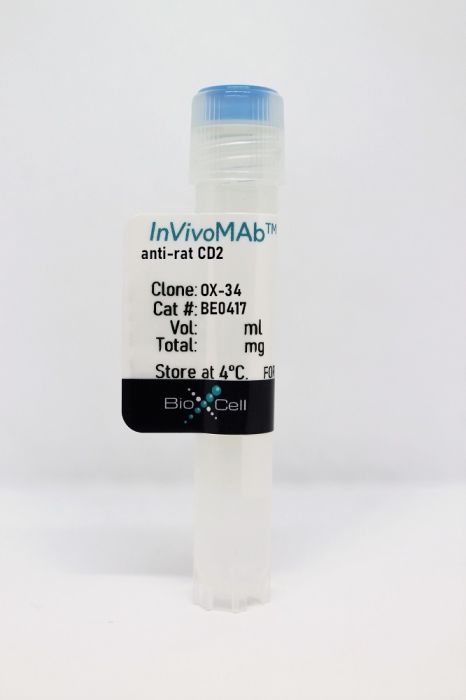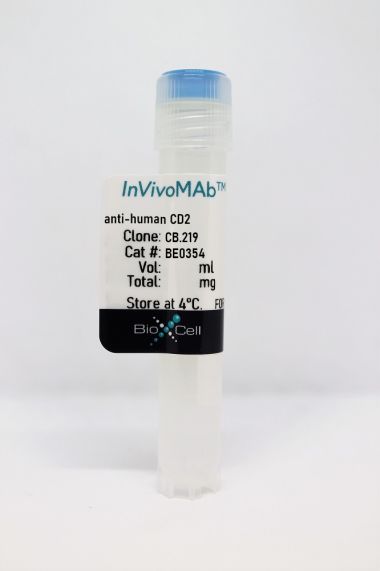InVivoMAb anti-rat CD2
Product Details
The OX-34 monoclonal antibody reacts with rat CD2, a 45-58 kD type I transmembrane glycoprotein, also known as LFA-2, T11 or Ly37. CD2 is a member of the Ig superfamily. CD2 is expressed by peripheral blood lymphocytes, thymocytes, all T cells that form E-rosettes, and a subset of NK cells. CD2 functions as an adhesion receptor that binds to CD58 resulting in the activation of CD2-positive T cells and NK cells and in the regulation of their cytolytic activities. The OX-34 antibody has been shown to block the binding of CD2 to CD48 and attenuate established adjuvant arthritis in rats.Specifications
| Isotype | Mouse IgG2a, κ |
|---|---|
| Recommended Isotype Control(s) | InVivoMAb mouse IgG2a isotype control, unknown specificity |
| Recommended Dilution Buffer | InVivoPure pH 7.0 Dilution Buffer |
| Conjugation | This product is unconjugated. Conjugation is available via our Antibody Conjugation Services. |
| Immunogen | Rat T Blasts |
| Reported Applications |
in vivo CD2 blockade in vitro CD2 blockade Western blot |
| Formulation |
PBS, pH 7.0 Contains no stabilizers or preservatives |
| Endotoxin |
<2EU/mg (<0.002EU/μg) Determined by LAL gel clotting assay |
| Purity |
>95% Determined by SDS-PAGE |
| Sterility | 0.2 µm filtration |
| Production | Purified from cell culture supernatant in an animal-free facility |
| Purification | Protein G |
| Molecular Weight | 150 kDa |
| Storage | The antibody solution should be stored at the stock concentration at 4°C. Do not freeze. |
Recommended Products
in vivo CD2 blockade
Hoffmann JC, Herklotz C, Zeidler H, Bayer B, Westermann J. (1997). "Anti-CD2 (OX34) MoAb treatment of adjuvant arthritic rats: attenuation of established arthritis, selective depletion of CD4+ T cells, and CD2 down-modulation" Clin Exp Immunol 110(1):63-71. PubMed
Anti-CD2 MoAbs have previously been shown to induce tolerance and to block B cell differentiation, T cell and monocyte activation. Since these immune functions are important in joint inflammation, we asked whether administration of the anti-CD2 MoAb OX34 has a beneficial effect on established rat adjuvant arthritis, a model of human rheumatoid arthritis, and how it affects CD2-bearing leucocyte subsets. Female Lewis rats with established adjuvant arthritis received a total of 5 mg OX34 or isotype-matched control MoAb starting on day 15 after adjuvant injection. Weight and arthritis score (AS) were measured in a blinded fashion. Peripheral blood cells were analysed for numbers of leucocyte subsets at various time points. Animals were killed on day 30 and lymphatic organs were processed for immunohistology. Clinically, OX34 treatment led to increased body weight and reduced AS. Although OX34 binds to CD4+ and CD8+ T cells in a comparable fashion, OX34 treatment reduced CD4+ T cells, but not CD8+ T cells. Among CD4+ T cells CD45RC+ ('naive') T cells virtually disappeared; CD45RC- ('recently activated') T cells were slightly reduced. A reduction of CD4+ T cells was also found in the lung, liver, bone marrow, spleen and lymph nodes. Down-modulation of the CD2 molecule by OX34, again, affected CD4+ T cells, suggesting a specific signal for CD4+ but not CD8+ T cells. In conclusion, the anti-CD2 MoAb OX34 attenuates established rat adjuvant arthritis. In spite of similar binding to CD4+ and CD8+ T cells, OX34 depletes only CD4+ T cells and down-modulates the CD2 molecule on these cells. These results suggest a therapeutic benefit from CD2-directed therapy for chronic types of arthritis.
in vivo CD2 blockade
Hoffmann JC, Herklotz C, Zeidler H, Bayer B, Rosenthal H, Westermann J. (1997). "Initiation and perpetuation of rat adjuvant arthritis is inhibited by the anti-CD2 monoclonal antibody (mAb) OX34" Ann Rheum Dis 56(12):716-22. PubMed
The purpose of this study was to investigate the therapeutic potential of the anti-CD2 mAb OX34 first with regard to bone protection in established rat adjuvant arthritis (AA) and secondly with regard to prevention of AA induction.
Western Blot
He Q, Beyers AD, Barclay AN, Williams AF. (1988). "A role in transmembrane signaling for the cytoplasmic domain of the CD2 T lymphocyte surface antigen" Cell 54(7):979-84. PubMed
The CD2 antigen can mediate mitogenesis of T lymphocytes after binding combinations of monoclonal antibodies. To examine the importance of the cytoplasmic domain in signaling, rat CD2 cDNA has been transfected into the human Jurkat cell line and triggering of an increase in cytoplasmic free Ca2+ concentration [( Ca2+]i) has been assayed. In cells expressing full-length CD2, a clear signal was triggered with anti-CD2 monoclonal antibodies. In contrast, a barely detectable increase in [Ca2+]i occurred with mutant rat CD2 molecules that included only 6 or 40 amino acids of the full-length cytoplasmic domain of 116 residues. It thus appears that the CD2 cytoplasmic domain plays a role in the signaling event.
in vitro CD2 blockade
Seaman WE, Eriksson E, Dobrow R, Imboden JB. (1987). "Inositol trisphosphate is generated by a rat natural killer cell tumor in response to target cells or to crosslinked monoclonal antibody OX-34: possible signaling role for the OX-34 determinant during activation by target cells" Proc Natl Acad Sci U S A 84(12):4239-43. PubMed
RNK-16 cells, rat leukemia cells with features of natural killer (NK) cells, were adapted for growth in vitro and used to examine the mechanism of NK-cell activation. Contact of RNK-16 cells with tumor cells (YAC-1) that are lysed by NK cells, but not with resistant tumor cells (EL-4, K562), led to an increase in inositol trisphosphate (InsP3), a Ca2+-mobilizing messenger. A similar increase in InsP3 could be elicited in RNK-16 cells by monoclonal antibody OX-34, when the antibody was crosslinked by F(ab')2 fragments of goat antibodies to mouse immunoglobulin. This reaction was accompanied by an increase in the concentration of cytoplasmic free calcium Ca2+, due primarily to the release of Ca2+ from intracellular stores. In contrast to the stimulatory effects of crosslinked OX-34, OX-34 alone did not affect the levels of either InsP3 or cytoplasmic free Ca2+. Moreover, OX-34 alone blocked the generation of InsP3 by RNK-16 cells in response to YAC-1 cells and prevented target-cell killing. These findings demonstrate that OX-34 identifies a structure on the surface of RNK-16 cells that can stimulate the generation of InsP3, and they suggest that this structure can regulate signal transduction during target-cell recognition by NK cells.





